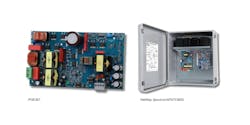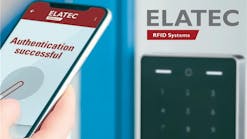If you’re familiar with code revisions nurtured by the Builders Hardware Manufacturers Association (BHMA), especially those relevant to locksmiths and other security professionals who work on doors within the commercial sector, then John Woestman, director of Codes & Regulatory Affairs for BHMA, has probably had a hand in bringing them to fruition.
As a trade association for North American manufacturers of commercial builders' hardware, BHMA is involved in standards, codes and life safety regulations and other activities that specifically impact builders’ hardware performance standards for locks, closers, exit devices and other builders’ hardware. It the only organization accredited by the American National Standards Institute (ANSI) to develop and maintain builders’ hardware performance standards.
“Our members produce what I'll describe as the products that open doors, close doors, hold doors open and keep doors closed as well as power-operated doors and revolving doors,” explains Woestman, whose advocacy on behalf of BHMA has resulted in revisions and updates to locking arrangements in the means of egress and corresponding requirements in the ICC IBC and IFC, and in NFPA 101.
From Concept to Code
The code-making process, as one would expect, is a lengthy one, and from concept to approval, can take more than three years to complete.
“For the 2027 version of the International Building Code, the International Fire Code, for example, proposals for revisions were due to ICC for their code development process early in January of 2024,” Woestman explains. “And then there were two rounds of public debate this year, in April and November, and then the third round of public debate will occur in April of 2026.”
Ideas for new codes and revisions are generated by BHMA members and from within committee groups, such as the Codes, Government & Industry Affairs committee, which is chaired by Mark Berger, general manager, Securitech Group, Inc./ASSA ABLOY, who works closely with Woestman.
“We meet regularly on conference calls, and I'll remind the members that as you go about your daily work with your colleagues and people in your company, and the people you interact with, if you run across code language that is not clear, not concise, not consistently interpreted, applied, enforced, etc., please let me know,” he says. “Let me know what's going on and how things are being seen differently. What are you seeing? So those are some of the ways within the membership that we get feedback.”
He continues, “Because my name is on code change proposals, every once in a while I'll get a call from a code official saying, ‘what does this language mean?’ or ‘help me better understand this part of the code.’ And if there's an opportunity for something to be included in the code, I put it on my list for the next time we're starting to work on code development changes for the next edition of the code.”
Putting Codes in Contex
Woestman and the team at BHMA do a great job at putting often complicated codes into easy-to-understand language that provides context for security manufacturers, locksmiths, security pros and code officials. Toward that end, BHMA has a resource on their website (https://buildershardware.com/Resources/Codes-In-Context) called Codes In Context, which is an ongoing series designed to provide relevant hardware requirements changes and updates during the various code cycles. Each edition of this series includes one-page Focus documents, which are in-depth summaries of each code update covered in the report.
The 2024 edition of Codes in Context provides a summary of updates to the 2024 IBC and IFC that affect doors, door hardware, and/or door operations. One 2024 update, for example, relates to bolt locks, and in previous editions of the I-Codes, a section called “Bolt Locks” was a frequent source of confusion. To aid in the understanding and application of the requirements of this section, the 2024 editions of the IBC and IFC include new definitions for dead bolts, manual bolts, automatic flush bolts, and constant latching bolts. In addition, a new table more clearly defines under what conditions these products may be used.
“There was some ambiguity in the language that led to different perspectives on what was permitted, so we worked to not change the requirements, but editorially make more sense of this section of the code,” says Woestman, noting that the goal is to eliminate any confusion within the code language.
Another good example in the 2024 edition involves “Electrical Locking Systems — Requiring electrical locks in some types of systems to be listed to either UL 294 or UL 1034.” These codes now require the electromechanical or electromagnetic locking devices in these special locking arrangements to be listed in accordance with either UL 294 or UL 1034, Standard for Burglary-Resistant Electric Locking Mechanisms.
As the Codes in Context section explains, including UL 1034 as an alternative to UL 294 better aligns this listing requirement in the IBC and IFC with the scope of these two UL standards in that many electrical locking devices are typically listed to UL 1034, rather than to UL 294. The revisions also clarified that it is the electromechanical or electromagnetic locking devices that must be listed, rather than the ambiguous “electrical locking system units” of the 2021 I-Codes and previous editions.
Another 2024 code revision relating to Access Control Systems was brought about because code officials were attempting to apply code provisions for access control systems (an electrical locking system on the ingress side/access side of the door) that have no effect on egress. If an access control system does not affect egress, that access control system is not addressed by the provisions in the IBC or IFC (except provisions for stairway re-entry into buildings; roofs not intended to be occupied; and door to balconies and decks).
“We were seeing where code officials were saying, ‘Okay, it's got an electrical locking system on it, we need to enforce the code, so code officials were trying to enforce something when they didn't need to enforce anything,” Woestman points out. “With this code update we're trying to provide that guidance that says, ‘If it doesn't affect egress, you don't have to worry about it.’”
Another good 2024 example involves “Doors with Panic Hardware — Change that prohibits sensor release electrical locking systems on doors required to have panic hardware.” In Section 1010.2.8 of the 2024 IBC, a change was made that prohibits sensor release locking systems from being installed on doors that are required to be equipped with panic hardware or fire exit hardware. The 2021 editions of the I-Codes allowed the use of either a sensor release system or a door hardware release system on doors with panic hardware, but this changed in the 2024 edition. The result of this change is that if a door is required to have panic hardware, and the door is also equipped with an electromagnetic lock for example, the electromagnetic lock must be released by operation of the panic hardware.
Future Code Proposals
As Woestman pointed out earlier, code proposals that will be included in the 2027 version of the IBC have already gone through public debate and have been recommended for approval.
“We had 15 proposals and nine of them were approved and didn't receive any public comments, so for those nine proposals, unless somebody appeals those actions, they will be included in the 2027 edition,” he says.
One of those approved proposals for 2027 involves a code revision for schools and classroom doors and exterior doors and locking arrangements (E57-24).
“This proposal revises from language that says, ‘shall be permitted’ to lock classroom doors to ‘shall be required’ that the classroom doors and other occupied rooms need to be capable of being locked to prevent the bad guy from getting in,” Woestman explains. “It also adds ‘shall be required’ language for exterior doors to be required to be lockable to prevent the bad guy from getting in. These proposed requirements are consistent with a long list of recommendations by people who have studied shooting incidents at schools.”
As Woestman pointed out at the hearing for the proposal, from a “best practices” perspective, this is what schools are doing today.
“If you put yourself in the shoes of people who are moving into new schools, they would expect this in new schools today,” he asserts, noting that the school code proposal was approved without changes. “This language, as submitted and published will be included in the 2027 version of the IBC.”
For Woestman, this is a lifelong labor of love, and it shows.
Paul Ragusa | Senior Editor
Paul Ragusa is senior editor for Locksmith Ledger. He has worked as an editor in the security industry for nearly 10 years. He can be reached at [email protected].







